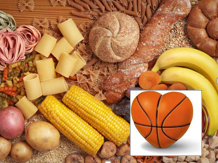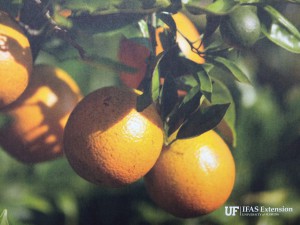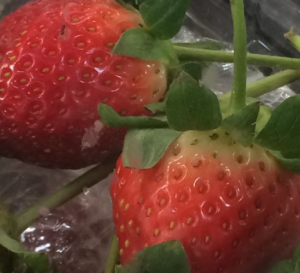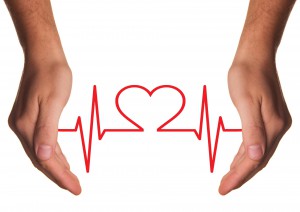
by Angela Hinkle | Mar 11, 2016
 Starchy foods are healthy – eat them! Starchy foods make you fat – don’t eat them! How do you score a healthy starch bracket with all this contradictory madness? For each round of your daily eating game, choose a variety of healthy starchy foods made up of whole grains, vegetables, and fruits. These starchy foods are rich in vitamins, minerals, and fiber and are the main source of carbohydrates to provide our muscles, brain, and other organs with energy.
Starchy foods are healthy – eat them! Starchy foods make you fat – don’t eat them! How do you score a healthy starch bracket with all this contradictory madness? For each round of your daily eating game, choose a variety of healthy starchy foods made up of whole grains, vegetables, and fruits. These starchy foods are rich in vitamins, minerals, and fiber and are the main source of carbohydrates to provide our muscles, brain, and other organs with energy.
Choose starchy foods with little or no added fats, sugar, or sodium. Give these starchy foods a spin in your diet: whole wheat flour, pumpkin, popcorn, brown rice, potato with the skin, corn, whole grain barley, acorn squash, oatmeal, quinoa, green peas, and plantains or bananas.
Try whole grain cereals for breakfast, a baked potato with the skin as part of your lunch, and squash with brown rice with your dinner.
Try to keep the processed white flour products with added sugar to a minimum. These starchy foods are the ones that tend to add on the pounds without the good-for-you nutrients.
Don’t just stay in the game, be a slam dunk winner! Eat healthy starchy foods every day.
For more information, check out this site from the American Diabetes Association. http://www.diabetes.org/food-and-fitness/food/what-can-i-eat/making-healthy-food-choices/grains-and-starchy-vegetables.html
by Heidi Copeland | Feb 23, 2016
 What’s in season now is certainly variable, location being a major influence in this area. Chances are, if you’re from a cold weather state and enjoying the Florida sunshine, expectations are a bit different than if you are from around these parts. Nonetheless, according to the Florida Department of Agriculture and Consumer Services (FDACS), oranges are not a variable here. They are one of the most popular fruits- folks from around the globe know about Florida. For instance, did you know that the orange is the official Florida fruit? It’s no surprise that orange juice is the official Florida state beverage and the orange blossom is Florida’s state flower.
What’s in season now is certainly variable, location being a major influence in this area. Chances are, if you’re from a cold weather state and enjoying the Florida sunshine, expectations are a bit different than if you are from around these parts. Nonetheless, according to the Florida Department of Agriculture and Consumer Services (FDACS), oranges are not a variable here. They are one of the most popular fruits- folks from around the globe know about Florida. For instance, did you know that the orange is the official Florida fruit? It’s no surprise that orange juice is the official Florida state beverage and the orange blossom is Florida’s state flower.
Oranges, a member of the citrus family along with other seasonal favorites like grapefruit and tangerine, are considered a nutrient dense food. Oranges provide valuable calories in the form of carbohydrates and fiber plus they are high in vitamin C, the minerals potassium and phosphorus, plus other nutrients. Not only do Florida oranges make for a delicious, refreshing FAST FOOD when eaten right out of the hand, they can be easily peeled and sectioned, zested, or juiced to add flavor and nutrition to many recipes. Oranges flavor well with other seasonal fresh foods, too. According to FDACS they pair nicely with basil, chocolate, cinnamon, ginger, mangoes, olives, pecans, strawberries and vanilla. Florida oranges can even make a beautiful garnish to enhance a beverage or dinner plate.
Expand your use of the Florida orange this October-June growing season by trying these simple tips:
Squeeze your own juice! Use it to:
- Give seasonal vegetables a new taste
- Make a simple marinade for poultry
- Enhance the flavor of a fruit salad or beverage
Zest an orange!
- Zest can be added to many dishes to enhance flavor (rice, vegetables, baked goods, beverages, salads)
- Care should be taken not to remove the white pith along with the peel as this can be bitter.
Peel an orange! Add the segments to:
- Garden fresh salads
- Pasta
- Poultry recipes
When choosing Florida fresh oranges, choose one that is firm and heavy for its size. Refrigerating prolongs the life an orange.
Why eat seasonally? Products are fresher and tastier, and nutritional value is optimized. Not only are oranges plentiful this time of year, but other seasonal produce is bountiful too. Try some fresh local Florida produce today!
http://www.freshfromflorida.com/content/download/16795/269924/03March.pdf
Orange and Tupelo Honey Bliss
(a delicious salad dressing, marinade or dipping sauce)
1 Teaspoon fresh grated orange *zest
Juice of one fresh Florida orange
1/4 cup Tupelo honey
1/4 cup plain vinegar
1/4 cup olive oil
Combine all ingredients and mix well.
Personalize this recipe by adding dried or fresh herbs, garlic, peppers or other Florida fresh citrus zest* and juice.
*Zest, also known as citrus peel, is a food ingredient that is prepared by scraping or cutting from the outer, colorful skin of or citrus fruit.
by Heidi Copeland | Feb 20, 2016
 Although cool weather certainly makes Floridians feel like they’re experiencing winter, Florida farms are working in overdrive this February producing agricultural products for a whole lot of people who, because of COLD weather, are not able to grow their own crops. .
Although cool weather certainly makes Floridians feel like they’re experiencing winter, Florida farms are working in overdrive this February producing agricultural products for a whole lot of people who, because of COLD weather, are not able to grow their own crops. .
The Florida Department of Agriculture and Consumer Services states that “Consumers around the world look for and value the “Fresh From Florida” label”. Because seasonal products are fresher and tastier, nutritional value is optimized. Often, seasonal products are more economical. In fact, fall plantings are not only being labeled as Fresh from Florida but also as what is in season right now. February’s list is quite impressive; especially when you think about the delicate nature of a strawberry!
Can you believe that each winter close to 300 million pounds of strawberries are grown in Central Florida, earning the area around Plant City the title Winter Strawberry Capital of the World!
Florida strawberries are indeed delicious and they’re full of Vitamin C and other vitamins and minerals – a real nutrient dense food.
When shopping for Florida Fresh strawberries:
- Know that strawberries, once picked, do not ripen further.
- Only purchase strawberries that can be consumed in a few days. Even when properly stored in a refrigerator, strawberries last only a few days.
Choose berries that are:
- Firm, plump, and free of mold.
- Shiny, deep red in color with attached green caps.
Avoid strawberries that are:
- Dull in color or have green or yellow patches.
If you are buying strawberries prepackaged in container ensure:
- Strawberries are not packed too tightly (which may cause them to become crushed and damaged.
- The container has no signs of stains or moisture, (indication of possible spoilage).
- The cap, stem and white hull remain intact (this prevents unnecessary loss of moisture).
- Strawberries are not left at room temperature or exposed to sunlight (this aides in their spoiling).
Since strawberries are very perishable, strawberries should not be washed until right before eating or using in a recipe.
- Do not remove strawberry caps and stems until after they have been gently washed under cold running water and patted dry. This will prevent them from absorbing excess water, which can degrade strawberries’ texture and flavor and cause them to spoil.
To freeze strawberries:
- Gently wash strawberries and pat dry. The cap and stem can either be removed or left intact, depending upon what you will do with them once they are thawed.
- Arrange strawberries in a single layer on a flat pan or cookie sheet and place them in the freezer. (lining the tray with a piece of parchment paper makes for easy removal once frozen)
- Once frozen, transfer the strawberries to a heavy plastic bag and return them to the freezer where they will keep for up to one year.
Try these simple ideas for including strawberries in your next meals and snacks:
- Strawberry and Spinach Salad
- Strawberry-Banana Smoothie
- Strawberry, Pistachio and Goat Cheese Pizza
Fore more information, contact: http://strawberrysue.com/
http://www.freshfromflorida.com/Divisions-Offices/Marketing-and-Development/Consumer-Resources/Buy-Fresh-From-Florida/Crops-in-Season
by Ginny Hinton | Feb 10, 2016
 Sometimes canned foods get a bad rap. Often, concerns are valid because canned foods tend to be high in unwanted salt and/or sugar. The good news is that you can buy fruits canned in their own juice and vegetables or beans labeled “low-sodium or” no salt added”. By draining and rinsing your canned produce with water, you can also lower the sodium or sugar content and have a healthful – and inexpensive – solution to balancing your child’s nutritional needs. For example, draining and rinsing canned beans lowers their sodium levels by as much as 41 percent.
Sometimes canned foods get a bad rap. Often, concerns are valid because canned foods tend to be high in unwanted salt and/or sugar. The good news is that you can buy fruits canned in their own juice and vegetables or beans labeled “low-sodium or” no salt added”. By draining and rinsing your canned produce with water, you can also lower the sodium or sugar content and have a healthful – and inexpensive – solution to balancing your child’s nutritional needs. For example, draining and rinsing canned beans lowers their sodium levels by as much as 41 percent.
We know that buying local fresh fruits and vegetables in season is a smart idea but kids can be picky. The Brussels sprouts or turnips that are available in the winter might not appeal to a child who only wants peaches. Benefits of buying canned foods include:
- Most canned fruits and vegetables are packaged within hours of being picked. This means the foods keep their peak flavor and nutrients.
- Canned fruits and vegetables are peeled, cut and ready to use in recipes. They “get you there” quicker and easier, usually with the same or even more nutrition than fresh or frozen. For example, did you know that canned pumpkin has three times more Vitamin A than fresh pumpkin?
- Canned fruit and vegetable selections are available year-round. Canned foods can offer reliable, great-tasting ingredients when fresh produce is not in season.
- Canned foods can be used in recipe “hacks” to improve nutrition. (“Hacks” are tricks that aid in the preparation or reduce the cooking time in recipes.) For example, soups can be thickened with a combination of pureed canned white beans and low-sodium vegetable or chicken stock instead of the traditional – and fattening – flour and butter. Canned evaporated skim milk can be used in equal amounts to replace cream in recipes for a fraction of the fat content.
All in all, canned foods can be used in any season to create a healthy plate. Just watch the sugar and salt content to create inexpensive, healthful and tasty meals your kids will love!
References:
- Kendall, A.R. and Dahl, W.J. (2015). Shopping for Health: Vegetables. University of Florida/IFAS electronic publication: edis.ifas.ufl.edu/fs165.
- Jones, J.B., and J.R. Mount. (2009). Sodium Reduction in Canned Bean Varieties by Draining and Rinsing. 209. Institute of Food Technologists Conference Poster. Anaheim, California.
- Tavoletti, R. (2015). The Time is “Ripe” for Canned Food. Canned Food Alliance. http://www.mealtime.org/article/the-time-is-ripe-for-canned-food.aspx?siteLocation=c8e9a60a-8e4d-45ef-9434-624be5cbf61b
- Lydon, K. (2015). It’s No Trick, Treat Yourself to Better Nutrition with These Recipe Hacks. Canned Food Alliance. http://www.mealtime.org/article/its-no-trick-canned-food-recipe-hacks.aspx?siteLocation=c8e9a60a-8e4d-45ef-9434-624be5cbf61b .
by Amy Mullins, PhD, RDN | Feb 3, 2016

Photo credit: pixabay.com
Did you know that heart disease is the #1 killer of Americans, accounting for 1 in every 4 deaths? It has been called the “silent killer” because often there are no symptoms.
Your risk for heart disease can depend on many things. The good news is that 80% of risk factors are preventable!
Things you can do to reduce your risk:
- Avoid use of and exposure to tobacco.
- Avoid excessive alcohol consumption.
- Be physically active every day.
- 150 minutes per week of aerobic activity, equivalent to brisk walking, has been shown to lower obesity, blood pressure, triglycerides, and LDL (bad) cholesterol, and increase HDL (good) cholesterol
- Aim for a healthy body weight.
- Aim for normal blood glucose. Diabetes is the 7th leading cause of death in the US and can cause serious health complications such as heart disease, blindness, kidney failure, and amputations.
- Fasting glucose levels over 100mg/dL could signify prediabetes
- Fasting glucose levels over 126mg/dL could signify diabetes
- Check your blood pressure regularly.
- Less than 120/80 mmHg is normal
- 120-139/80-89 mmHg is pre-hypertension
- 140/90 mmHg or higher is hypertension
- Check your cholesterol. People with high cholesterol have about twice the risk of heart disease as people with lower levels. Aim for:
- Total Cholesterol (less than 200 mg/dL)
- Low triglycerides (less than 150 mg/dL)
- Low LDL (bad) cholesterol levels (less than 100 mg/dL)
- High HDL (good) levels (60 mg/dL or higher)
- Consume a healthy diet. According to the Dietary Guidelines for Americans and ChooseMyPlate, a healthy eating plan:
- Emphasizes fruits, vegetables, whole grains, and fat-free or low-fat milk and milk products
- Includes lean meats, poultry, fish, beans, eggs, and nuts
- Is low in saturated fats, trans fats, cholesterol, salt (sodium), and added sugars
- Stays within your daily calorie needs
Taking care of yourself is no easy job! Talk to your doctor and schedule regular checkups. Knowing what your risk for heart disease is literally can save your life. For more information about reducing your risk of heart disease, visit the Centers for Disease Control and Prevention.

by Shelley Swenson | Jan 15, 2016
 Valentine’s Day and chocolate just go together! Can you really have one without the other? I crave chocolate all year round and with some of the recent research I have read, I can feel all right about giving in.
Valentine’s Day and chocolate just go together! Can you really have one without the other? I crave chocolate all year round and with some of the recent research I have read, I can feel all right about giving in.
A recent study reported in the American Journal of Clinical Nutrition tested the effects of dark and white chocolate on healthy adults to determine whether either type played a role in blood pressure and insulin sensitivity. They concluded that dark chocolate can indeed help reduce blood pressure and insulin resistance. White chocolate did not provide these health benefits.
Keep in mind that although dark chocolate has health benefits, most chocolate bars are high in saturated fat, so moderation is key. Eating dark chocolate cannot substitute for everyday healthy food choices. Nor can chocolate replace regular exercise or medications that have been prescribed by your physician. It is so nice to know you can indulge in your Valentine’s Day chocolate, in moderation, without feeling guilty about it if you choose the dark.

 Starchy foods are healthy – eat them! Starchy foods make you fat – don’t eat them! How do you score a healthy starch bracket with all this contradictory madness? For each round of your daily eating game, choose a variety of healthy starchy foods made up of whole grains, vegetables, and fruits. These starchy foods are rich in vitamins, minerals, and fiber and are the main source of carbohydrates to provide our muscles, brain, and other organs with energy.
Starchy foods are healthy – eat them! Starchy foods make you fat – don’t eat them! How do you score a healthy starch bracket with all this contradictory madness? For each round of your daily eating game, choose a variety of healthy starchy foods made up of whole grains, vegetables, and fruits. These starchy foods are rich in vitamins, minerals, and fiber and are the main source of carbohydrates to provide our muscles, brain, and other organs with energy.





